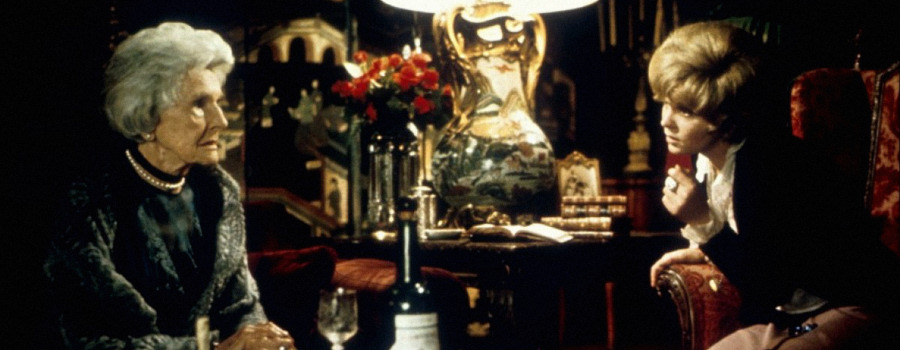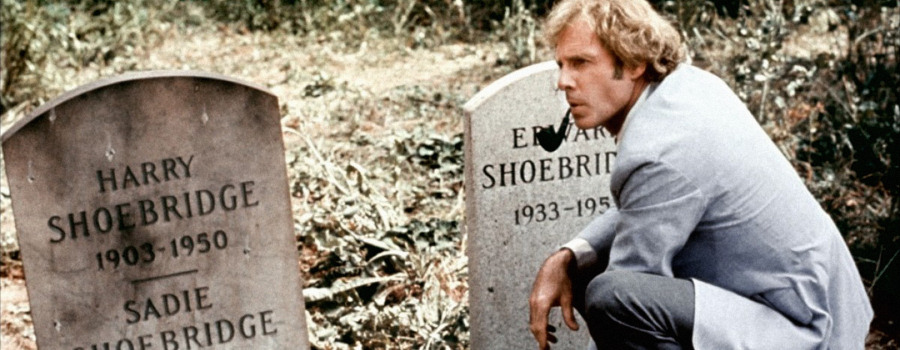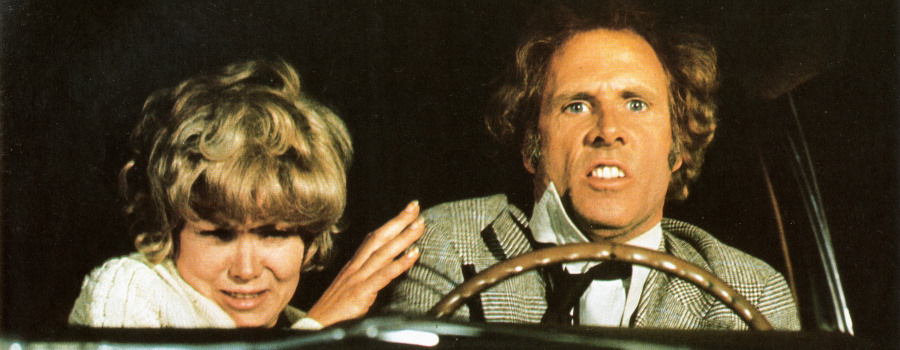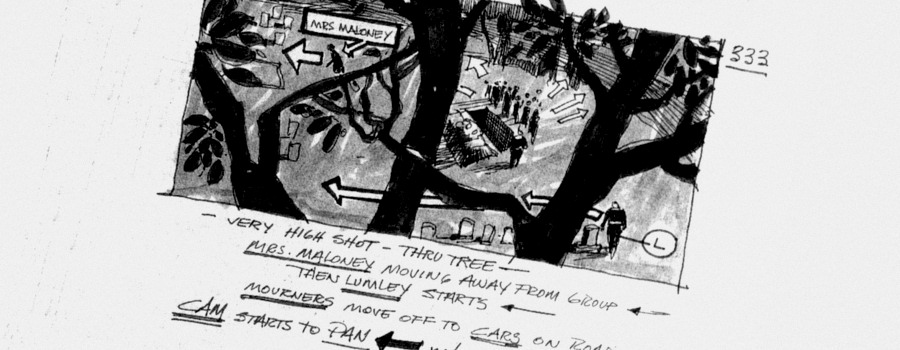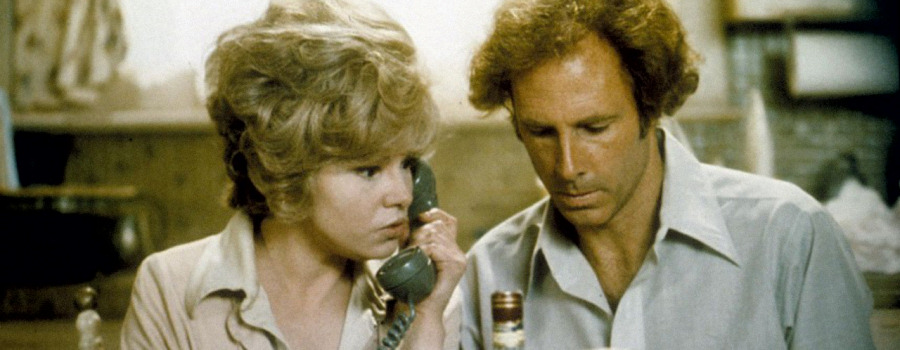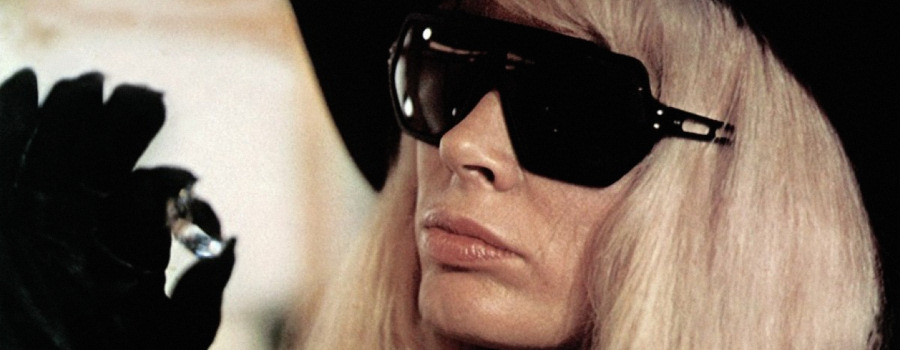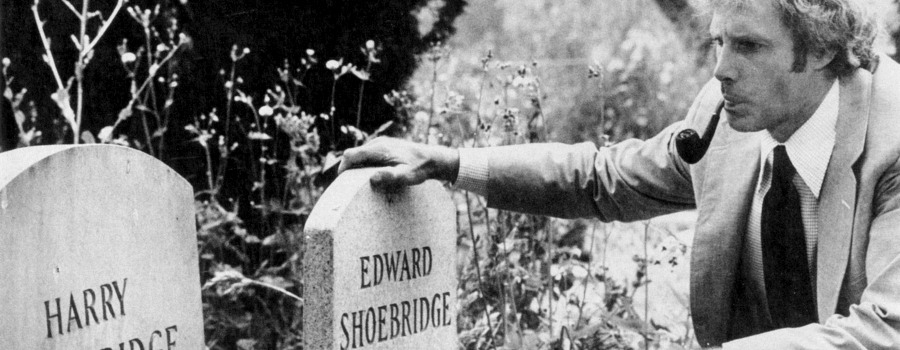Family Plot (1976)
| There's no body in the family plot. | |
/0003.jpg) | |
| Alfred Hitchcock | |
| Alfred Hitchcock | |
| Ernest Lehman | |
| "The Rainbird Pattern" by Victor Canning | |
| Barbara Harris Bruce Dern Karen Black William Devane | |
| John Williams | |
| Leonard J. South | |
| J. Terry Williams | |
| 121 minutes | |
| colour (Technicolor) | |
| mono (Westrex Recording System) | |
| 1.85:1 | |
| Universal Pictures | |
| Universal Pictures | |
| DVD & Blu-ray | |
Synopsis
Spiritualist Blanche Tyler is asked to locate a missing heir, whom she pursues with her cab driver boyfriend Geroge Lumley, an unemployed actor. The man they seek, Arthur Adamson, is posing as a legitimate jeweler while kidnapping wealthy people for a ransom in diamonds. He is assisted by his girlfriend, Fran.
Production
After the release of Frenzy, Hitchcock spent several months recuperating, often staying at home with Alma and browsing books that the Universal story department had sent him. Around this time, according to Patrick McGilligan, the director seriously considered making a cold war spy thriller, possibly even setting the film entirely in Russia.[1]
In 1973, whilst dining with Richard Levinson and William Link, Hitchcock expressed his frustration at not being able to find a suitable book to adapt. The two writers suggested that Victor Canning's 1972 novel The Rainbird Pattern might be of interest and felt that the plot would make an ideal Hitchcockian crime thriller. The novel has two separate story threads — firstly the search by a clairvoyant and her out-of-work partner to find a missing heir, secondly a husband and wife team who kidnap prominent officials to ransom for diamonds — which eventually converge leaving virtually all of the main characters dead. After Alma read the novel and approved it, Hitchcock selected it as his next project.[1]
Pre-Production
Screenplay
Hitchcock initially approached Anthony Shaffer, but the playwright expressed reservations about the angle Hitchcock was considering, which he regarded as being too much like Noël Coward's Blithe Spirit. By September 1973, Ernest Lehman had been persuaded to do the adaptation — Hitchcock explained that he intended to keep only the bare-bones of Canning's novel and to relocate the story from England to California. One of the early decisions was to drop Canning's title and the project was branded Deceit.[2]
Script meetings progressed slowly but steadily and Lehman completed a first draft by April 1974. However, the initial energy of the project had begun to wane and they both began to have doubts the scripts could be completed — Lehman grew weary of Hitchcock over-analysing every detail and the director complained privately in letters to Michael Balcon that Lehman was "a very nervous and edgy sort of man" who was deliberately making things difficult for him. When Hitchcock suffered a heart attack in September, he half-jokingly blamed it on the stress Lehman was causing him.[3]
Hitchcock had suffered a number of health scares since completing Frenzy and, following an operation to be fitted with a pacemaker, he was hospitalised again for colitis and then kidney stones. Already struggling with arthritis, he then had a series of debilitating falls. Towards the end of 1974, it seemed increasingly unlikely Deceit would move into production, despite the fact that Lehman was still working away on the script.[4]
Casting
Hitchcock's health rebounded at the start of 1975 and he began to cast Deceit.
For the roles of Blanche the clairvoyant and her partner George, Universal suggested Liza Minnelli and Hitchcock considered Jack Nicholson, however the actor was busy preparing for One Flew Over the Cuckoo's Nest and Minnelli's salary would have compromised the film's budget. Instead, Hitchcock settled for Broadway stage actress Barbara Harris, who had recently starred as a psychic in the stage play On a Clear Day You Can See Forever, and Bruce Dern, who had played a small but memorable role in Marnie (1964).
Hitchcock met with actress Karen Black in February and immediately cast her as Fran, the villain's wife. For the villain, Arthur Adamson — nicknamed "The Trader" — the director initially considered casting an "old Hollywood" actor to counterbalance the younger actors, such as John Houseman. Hitchcock eventually selected Universal's suggestion of Roy Thinnes.
For the elderly Julia Rainbird, Hitchcock cast 87-year-old Cathleen Nesbitt who he'd first seen on the London stage in the 1920s, appearing in J.M. Barrie and John Galsworthy plays.
Principal Photography
With the the start of production looming, Lehman submitted his final screenplay in April 1975 and filming for Alfred Hitchcock's Deceit began on May 12th.[5][6]
On Thursday May 29th, Hitchcock and his cast spent much of the day entertaining journalists and film critics on a specially constructed cemetery set where lunch was served. Fake tombstones were engraved with the names of those attending.[7]
Although the majority of filming took place on the Universal sound stages, some location filming was done. Hitchcock was keen for the city locations to be generic, so scenes were shot in both Los Angeles and San Francisco. However, throughout the shoot, Hitchcock's health remained a constant concern for the studio executives — Universal's Thom Mount later told Charlotte Chandler:
For Family Plot, a lot of the work was done on the soundstage, but Mr. Hitchcock had a very hard time standing up for any lengthy period of time. Walking was not his strong suit by that time, so we took an old Cadillac convertible and a welding torch, and we cut the sides, and the back off of it, fitted a flat platform on the back of the Cadillac, and on that flat platform we put a chair for a cinematographer, as if it were a crane that was mounted on a hydraulic lift. Mr. Hitchcock would sit in the chair and move himself around in any direction and see in all directions. The Cadillac was moved all around the soundstage, even though they were interiors, just backing it into place, wherever it needed to be. And so Mr. Hitchcock could move around.[8]
Early in the production, it became apparent that Hitchcock was having serious doubts about Roy Thinnes, who had provided the director with a list of character traits he thought The Trader should have. Shortly after filming the scene where the bishop is kidnapped, Thinnes was fired and actor William Devane was hired to replace him. According to Patrick McGilligan, Hitchcock had apparently anticipated this might happen and had purposefully shot some of Thinnes' scenes from behind, so that the actor's face wasn't visible, and this helped to minimise the number of reshoots required with Devane. As with previous Hitchcockian villains, played by actors such as James Mason, Robert Walker and Anthony Perkins, Devane was cast against type in the role.[9][10]
Despite Hitchcock's well-known distrust of method actors, by all accounts he got on extremely well with Barbara Harris, Karen Black and Bruce Dern during filming. Dern, in particular, took to joking with director and laughing loudly at his risqué jokes and later told an interviewer that when Hitchcock was alert, "[he] noticed everything — a shadow on a performer's face, a bad angle for a prop, a few seconds too long on a take. Just when we thought he had no idea what was going on, he'd snap us all to attention with the most incredible awareness of some small but disastrous detail that nobody would have noticed until it got on the screen."[11]
Partway through filming, Variety confirmed in mid-July that the film had been retitled Family Plot.[12] Around the same time, Hitchcock joked to journalists that he might end up calling the film Alfred Hitchcock's Wet Drawers.[13]
Post-Production
Rather than using standard rear projection for the driving scenes, Universal persuaded Hitchcock to try an experimental technique the studio was developing which optically composited the background into the film frame. Unfortunately, the end result was substandard and criticised by many of the reviewers.
The Score
In November, Universal's music executive Harry Garfield recommended John Williams after Hitchcock had rejected an earlier suggestion by the studio to give Henry Mancini a second chance, following his rejected score for Frenzy. The composer had received considerable praise for his iconic score for Steven Spielberg's Jaws, which had been released whilst Family Plot was being filmed in June. The success of Jaws — which had quickly become the highest-grossing North American film of all time — had benefited Hitchcock, who was one of the largest shareholders in Universal.[14]
According to Williams, although he was keen to work with Hitchcock, he first sought approval from his friend Bernard Herrmann before accepting the offer. At the time, Herrmann was in London working on Martin Scorsese's Taxi Driver. Herrmann then flew to New York in December to record the score and passed away on Christmas Eve, just a few hours after completing the recording.[14]
The composer met regularly with Hitchcock to discuss the score and to dine with the director, although the conversation frequently wandered on to other topics, such as Hitchcock's favourite composers, including Edward Elgar.[15] Whilst discussing the tone for the score, Hitchcock recounted how Mancini had used "double bass and bassoon and timpani, and every instrument in the city of London capable of making an ominous, lugubrious sound" for the rejected Frenzy score. When Williams commented, "it seems for a murder that's very appropriate", Hitchcock responded, "Mr. Williams... murder can be fun!"[14]
Williams recorded his score over three days from January 12th, 1976, conducting the Hollywood Studio Symphony at the Universal City Studios Scoring Stage. Hitchcock, who had just returned from what would prove to be his final Christmas trip to St. Moritz and was again struggling again with health problems, briefly attended one of the sessions and nodded his approval.
The studio recording was initially released on CD as a bootleg in 2007 before being officially released by Varèse Sarabande in 2010.
In 2012, Classic FM interviewed Williams about his career for a two-hour long broadcast special, which included a short discussion about Hitchcock and Family Plot: Error loading file:"JohnWilliamsClassicFM23Aug2012.mp3"
The following year, Williams spoke about Hitchcock for the BBC Radio "Composer of the Week" series:
Error loading file:"JohnWilliamsHitchcock2013.mp3"
Release & Reception
The film was premiered at Filmex, the Los Angeles International Film Festival, on March 21st. Two days later, Hitchcock took part in a lengthy video press conference hosted by Richard Schickel.
Many of the reviews were warmly positive. The Times noted that the film "has the geometric ingenuity of the later American work, along with the delight in quirky character that marked Hitchcock's British period [...] Yet what is most characteristic and charming in the film is a show-off relaxation, an easy demonstration of how it all should be done [...] It's all a very jolly affair."[16]
Penelope Gilliatt's review in The New Yorker began by noting the links to Mary Rose in the opening séance scene and ended by saying, "Hitchcock allows himself a camaraderie with the audience which makes this film one of the saltiest and most endearing he has ever directed." And, of Barbara Harris, "She has never before seemed so fully used."[17]
In his review for Commentary, William S. Pechter concluded by saying, "Perhaps it's true that what one sees in Family Plot is the reflection of an aged artist's attainment of tranquility: of a serene wisdom in which all those childhood terrors have been finally exorcised, and put behind him. If so, so much the better for Hitchcock. And so much the worse for us."[18]
The Independent Film Journal noted the "curiously sloppy process shots" which marred the film but felt that the film "is as solid an entertainment as any audience — at any level — could ever hope for."[19]
See Also...
For further relevant information about this film, see also...
- 1000 Frames of Family Plot (1976)
- articles about Family Plot (1976)
- awards and nominations
- books about Family Plot (1976)
- complete cast and crew
- documentaries
- filming locations
- publicity material (posters, lobby cards, etc)
- quotations relating to the film
- soundtrack albums
- trailers
- trivia
- web links to articles, information, reviews, etc
Blu-ray Releases
released in 2012

|
Family Plot (1976) - Universal (Blu-ray) available as an individual disc or as part of the box set Alfred Hitchcock: The Masterpiece Collection - Universal (Blu-ray, 2012) |
DVD Releases
released in 2006

|
Family Plot (1976) - Universal (USA, 2006) Amazon (USA) NTSC 1.85:1 (anamorphic) |
released in 2005

|
Family Plot (1976) - Universal (UK, 2005) Amazon (UK) PAL |

|
Family Plot (1976) - Universal (USA, 2005) - part of a box set Amazon (USA) NTSC 1.85:1 (anamorphic) [02:00:00] |
Image Gallery
Images from the Hitchcock Gallery (click to view larger versions or search for all relevant images)...
posters
lobby cards
other images
Film Frames

Themes
- the icy blonde - Karen Black in the blonde wig and Blanche Tyler (Barbara Harris)
- taboo: sex - Harriet's illegitimate child, and George's crystal balls
- taboo: bathrooms - a modern chemical toilet
- the MacGuffin - the diamonds
- the cultured baddie - Arthur Adamson is a respectable jeweller
- stairs - the final scene
- the Hitchcock cameo - in silhouette behind the door at the registrar of births and deaths (more details)
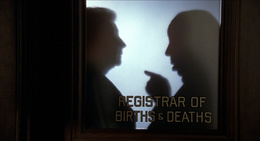
Cast and Crew
Directed by:
Starring:
- Karen Black - Fran
- Bruce Dern - George Lumley
- Barbara Harris - Blanche Tyler
- William Devane - Arthur Adamson
- Ed Lauter - Joe Maloney
- Cathleen Nesbitt - Julia Rainbird
- Katherine Helmond - Mrs Maloney
- Warren J Kemmerling - Grandison
- Edith Atwater - Mrs Clay
- William Prince - Bishop
- Nicholas Colasanto - Constantine
- Marge Redmond - Vera Hannagan
- John Lehne - Andy Bush
- Alexander Lockwood - Parson
- Charles Tyner - Wheeler
Produced by:
Written by:
- Victor Canning - original novel ("The Rainbird Pattern")
- Ernest Lehman
Photographed by:
Edited by:
Music by:
Costume Design by:
Production Design by:
Notes & References
- ↑ 1.0 1.1 Alfred Hitchcock: A Life in Darkness and Light (2003) by Patrick McGilligan, pages 715-16
- ↑ Alfred Hitchcock: A Life in Darkness and Light (2003) by Patrick McGilligan, page 716-17
- ↑ Alfred Hitchcock: A Life in Darkness and Light (2003) by Patrick McGilligan, pages 720-22
- ↑ Alfred Hitchcock: A Life in Darkness and Light (2003) by Patrick McGilligan, pages 722
- ↑ The Encyclopedia of Alfred Hitchcock (2002) by Thomas M. Leitch, page 100
- ↑ Alfred Hitchcock: A Life in Darkness and Light (2003) by Patrick McGilligan, page 725. McGilligan claims the press luncheon happened on the first day of shooting, but it took place 16 day later on the 29th.
- ↑ Variety (1975) - Pictures: Graveyard Stunting
- ↑ "It's Only a Movie" - by Charlotte Chandler (2006)
- ↑ Alfred Hitchcock: A Life in Darkness and Light (2003) by Patrick McGilligan, pages 725-26
- ↑ Variety (1975) - Pictures: Found and Lost Actor
- ↑ Alfred Hitchcock: A Life in Darkness and Light (2003) by Patrick McGilligan, page 727
- ↑ Variety (1975) - Pictures: Alfred Hitchcock's 53rd film
- ↑ San Antonio Express (31/Jul/1975)
- ↑ 14.0 14.1 14.2 Sleeve notes from Family Plot (VCL 1110 1115, 2010)
- ↑ Hitchcock selected Elgar's "Cockaigne" Overture (also known as "In London Town") when he appeared on BBC Radio's "Desert Island Discs" in October 1959.
- ↑ The Times (20/Aug/1976) - Family Plot
- ↑ The New Yorker (19/Apr/1976) - Hitch: Family Plot
- ↑ Commentary (1976) - Movies: Hitchcock in Retrospect
- ↑ The Independent Film Journal (1976) - Buying & Booking Guide: Family Plot
| Hitchcock's Major Films | |
| 1920s | The Pleasure Garden · The Mountain Eagle · The Lodger · Downhill · Easy Virtue · The Ring · The Farmer's Wife · Champagne · The Manxman · Blackmail |
| 1930s | Juno and the Paycock · Murder! · The Skin Game · Rich and Strange · Number Seventeen · Waltzes from Vienna · The Man Who Knew Too Much · The 39 Steps · Secret Agent · Sabotage · Young and Innocent · The Lady Vanishes · Jamaica Inn |
| 1940s | Rebecca · Foreign Correspondent · Mr and Mrs Smith · Suspicion · Saboteur · Shadow of a Doubt · Lifeboat · Spellbound · Notorious · The Paradine Case · Rope · Under Capricorn |
| 1950s | Stage Fright · Strangers on a Train · I Confess · Dial M for Murder · Rear Window · To Catch a Thief · The Trouble with Harry · The Man Who Knew Too Much · The Wrong Man · Vertigo · North by Northwest |
| 1960s | Psycho · The Birds · Marnie · Torn Curtain · Topaz |
| 1970s | Frenzy · Family Plot |
| view full filmography | |
